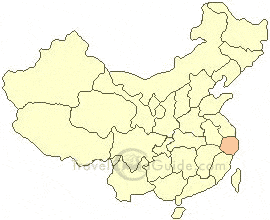No Romans This Time Edition
Archaeologists dig up 4300-year-old city
From correspondents in Beijing
December 04, 2007 05:56pm
CHINESE archaeologists have dug up what is believed to be a 4300-year-old city that could be the capital of China's oldest dynasty, state press said today.
The ancient city was believed to be part of the Liangzhu culture dated back to neolithic times between 4000 and 5300 years ago, the China Daily said.

Map of China showing location of Zhejiang Province, where the recently discovered ancient city is situated.

Detail map of Zhejiang Province, click to see larger version.
The Liangzhu is one a large number of neolithic cultures whose remains have been discovered in China. It seems to have begun in the mid-fourth millenium B.C., and lasted roughly 1500 years. Apparently, the Liangzhu people were extremely competent at agriculture (including animal husbandry and aquaculture), and seem to mark a transition from the earlier hunter-gatherer cultures to a less nomadic way of life. Liangzhu culture was extremely stratified, at least to judge from the archaeological remains, and was also very much into the whole human sacrifice thing. However, what the Liangzhu people are best known for is the extremely high quality jade artefacts that the culture produced.

Liangzhu jade "Cong", click to see larger version
Nobody can say with any great certainty was the Cong was used for; presumably it had some sort of ritual purpose, since it is very commonly found in Liangzhu tombs, along with numerous other jade artefacts.

Liangzhu tomb. Note the presence of Congs
Perceived similarity between the "monster faces" on some Liangzhu artefacts and Olmec art from what is now Mexico has caused speculation about the possibility of trans-Pacific trade. I must say that I can't see enough of a similarity myself to say "yes" to that notion with any certainty, but I would by no means rule it out.

Olmec were-jaguar head, 1200 B.C. to 400 B.C.
So, what is the overall significance of this putative city that has just been discovered? Well, if it does prove to have been a Liangzhu capital city, then it means that the Liangzhu people were in fact a "kingdom," rather than simply a group of culturally alike people living close together. Therefore, the Liangzhu would displace the Xia Dynasty as China's earliest known kingdom, and would in fact walk the origin of the Chinese dynasties back about 1500 years.


No comments:
Post a Comment